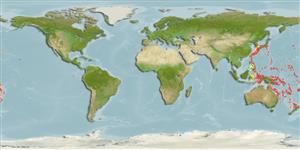Common names from other countries
Elasmobranquios (tiburones y rayas) (sharks and rays) >
Squaliformes (Sleeper and dogfish sharks) >
Squalidae (Dogfish sharks)
Etymology: Cirrhigaleus: Latin, cirrus = curl fringe + Greek, galeos = a shark (Ref. 45335).
More on author: Tanaka.
Environment: milieu / climate zone / depth range / distribution range
Ecología
marino batidemersal; rango de profundidad 140 - 650 m (Ref. 26346). Deep-water; 36°N - 40°S, 120°E - 173°W (Ref. 54331)
Western Pacific: southeastern Honshu in Japan, New South Wales in Australia, New Zealand, and Torres Island in Vanuatu.
Length at first maturity / Tamaño / Peso / Age
Maturity: Lm ?, range 92 - ? cm
Max length : 126 cm TL macho / no sexado; (Ref. 6871)
Espinas dorsales (total): 2; Radios blandos dorsales (total): 0; Espinas anales 0; Radios blandos anales: 0. Recognized by its tremendous, mandarin-like nasal barbels (Ref. 247).
Found on the uppermost continental and insular slopes, and probably the outer continental-insular shelves (Ref. 31367). Probably feeds on bottom fishes and some invertebrates (Ref. 247). Ovoviviparous (Ref. 205), with 10 pups in a litter (Ref. 247). Although not utilized commercially, the liver is relatively high in squalene oil (Ref. 6871).
Life cycle and mating behavior
Madurez | Reproducción | Puesta | Huevos | Fecundidad | Larva
Ovoviviparous with 10 young in a litter (5 per uterus).
Compagno, L.J.V., 1984. FAO Species Catalogue. Vol. 4. Sharks of the world. An annotated and illustrated catalogue of shark species known to date. Part 1 - Hexanchiformes to Lamniformes. FAO Fish. Synop. 125(4/1):1-249. Rome, FAO. (Ref. 247)
IUCN Red List Status (Ref. 130435)
CITES (Ref. 128078)
Not Evaluated
Threat to humans
Harmless
Human uses
Pesquerías: sin interés
Más información
ReferenciasAcuiculturaPerfil de acuiculturaRazasGenéticaElectrophoresesheritabilidadEnfermedadesProcesamientoMass conversion
ColaboradoresImágenesStamps, Coins Misc.SonidosCiguateraVelocidadTipo de nataciónSuperficie branquialOtolitosCerebrosVisión
Herramientas
Special reports
Download XML
Fuentes de Internet
Estimates based on models
Preferred temperature (Ref.
115969): 11.2 - 18.7, mean 13.8 (based on 39 cells).
Phylogenetic diversity index (Ref.
82804): PD
50 = 0.6250 [Uniqueness, from 0.5 = low to 2.0 = high].
Bayesian length-weight: a=0.00355 (0.00171 - 0.00737), b=3.10 (2.92 - 3.28), in cm Total Length, based on LWR estimates for this (Sub)family-body shape (Ref.
93245).
Nivel trófico (Ref.
69278): 4.0 ±0.61 se; based on food items.
Resiliencia (Ref.
120179): Bajo, población duplicada en un tiempo mínimo de 4.5-14 años (Fec=10).
Fishing Vulnerability (Ref.
59153): Very high vulnerability (76 of 100).
